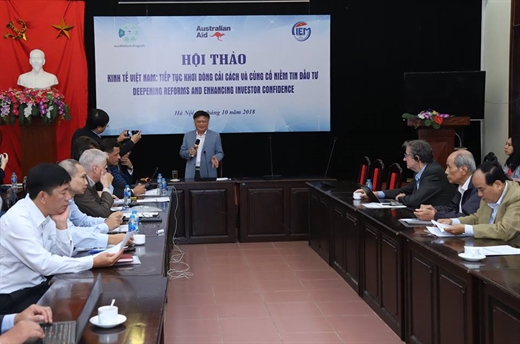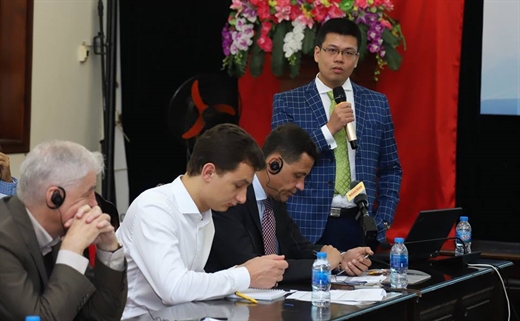Australia supports Economic Reform in Vietnam (Aus4Reform)
- en
- News and Media
- Aus4Reform News
- Bright prospects for Vietnam's economic growth in third quater of 2018
18/10/2018
Bright prospects for Vietnam's economic growth in third quater of 2018
In the morning of October 17th, under the framework of The Australian Support for Vietnam's Economic Reform (Aus4Reform Program), the Central Institute for Economic Management (CIEM) organized a workshop: "Vietnam's Economy: Deepening Reforms and Enhancing Investor Confidence" and announce the macroeconomic report for the third quarter of 2018.
Bright prospects for Vietnam's economic growth in third quater of 2018
In the morning of October 17th, under the framework of The Australian Support for Vietnam's Economic Reform (Aus4Reform Program), the Central Institute for Economic Management (CIEM) organized a workshop: "Vietnam's Economy: Deepening Reforms and Enhancing Investor Confidence" and announce the macroeconomic report for the third quarter of 2018.
 |
Workshop overview
In current, challenges are posed to Vietnam in macroeconomic management in the context of fluctuations in the world market. However, high economic growth in the first two quarters of this year are helping to significantly reduce the pressure on achieving the economic growth target in fourth quarter.
With the support of the Australian Support for Economic Reform Program (Aus4Reform Program), this morning on October 17th 2018, the Central Institute for Economic Management (CIEM) organized the workshop “Vietnam’s economy continues to reform and strengthen investor’s confidence” in order to: (i) Update, analyze and evaluate the macroeconomic performance of the third quarter as well as updating prospects in whole year 2018; (ii) Deeply analyze based on qualitative and / or quantitative evidence on some current outstanding economic issues; and (iii) Recommend a number of economic reform orientations (including economic institutions) and macroeconomic governance in the last months of 2018 and the following years.
Pressure to achieve growth target significantly reduced
The GDP growth rate reached 6.88% in the third quarter and 6.98% in the first nine months, higher than that of the same period for many years. Annual export growth is forecast at 13.34%. The trade surplus is forecast at $5.1 billion USD. The average inflation in 2018 is 3.97%. This has significantly reduced the pressure to achieve the economic growth target in the fourth quarter.
Notably, exports and disbursements of foreign investment increased steadily, helping to ensure the key indicators of the economy. Despite concerns regarding inflation risks at certain points, the 2018 inflation target (4% on average) is likely to be achieved.
The first nine months of the year have helped to better visualize the context and the results of socio-economic development in 2018. According to Nguyen Anh Duong (Head of the Macroeconomic Policy Department - CIEM): “More importantly, Vietnam has initially shown its ability to cope with unfavourable fluctuations in exchange rates and interest rates from the world market through international economic integration channels”.
 |
Mr. Nguyen Anh Duong, Head of CIEM’s Macroeconomic Policy Department speaking at the seminar.
Still, it is vital to pay attention to these changes in the context of the current administration (domestic inflationary pressures and the risk of aggregate global economic decline), albeit at a lower level compared with the end of the third quarter, the beginning of the fourth quarter of 2008
Forecasts the macroeconomic developments in the fouth quater
Macroeconomic reports for the third quater 2018 are quite positive for economic growth, but macroeconomic developments in the fouth quater are likely to be affected by a number of factors such as:
Firstly, the US-China trade tensions and US is unpredictable; because it depends on the ability of the United States and China to negotiate trade (if possible), as well as US policy consistency after midterm elections.
Secondly, the global financial market and emerging markets are becoming more vulnerable to the trend of increased protectionism and the volatility of investment flows.
Thirdly, those key economies have not yet explicitly intervened directly in the exchange rate policy.
The last, progress in negotiating and ratifying new free trade agreements (FTAs) (such as the RCEP, CPTPP and EVFTA) could strengthen the confidence of foreign investors in Vietnam.
With these factors, the commitment to macroeconomic stability and economic restructuring is necessary, but not enough. Vietnam needs to focus more than ability to monitor capital and commodity flows from markets into Vietnam and a flexible, pragmatic approach in economic relations with key partners.
Against this backdrop, the Vietnamese government has emphasised the need to strengthen macroeconomic fundamentals in order to create more policy dividend and to improve resilience in a volatile global economic environment. Paralleling, attempting to promote the ratification of important free trade agreements and encourage the private sector.
In conclusion, the workshop "Vietnam's Economy: Deepening Reforms and Enhancing Investor Confidence" emphasized the message that priority policy should continue to focus on improving microeconomic fundamentals, and reform the economic institution system in a way that is more friendly and creatively to innovation and the environment, connected with the effective handling of risks in the volatile international economic environment.
At seminar, the economists were discussed some of the recommendations for reforming the microeconomic platform was no longer a prominent action. In this context, the government's commitment to macroeconomic stability and economic restructuring is necessary, but not sufficient.

